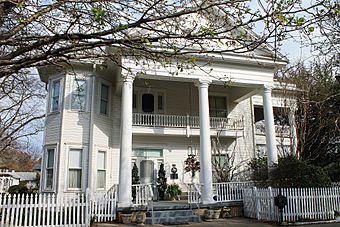Marcus DeWitt Carlock House facts for kids
|
Marcus DeWitt Carlock House
|
|

Marcus DeWitt Carlock House
|
|
| Location | 407 S. Main St., Winnsboro, Texas |
|---|---|
| Area | 1.2 acres (0.49 ha) |
| Built | 1903 |
| Built by | Jeff Frazier, Marcus DeWitt Carlock |
| Architectural style | Classical Revival |
| NRHP reference No. | 13000277 |
Quick facts for kids Significant dates |
|
| Added to NRHP | May 14, 2013 |
The Marcus DeWitt Carlock House is a historic home located in Winnsboro, Texas. You can find it at 407 South Main Street, just a few blocks from downtown. This house is special because it blends two cool architectural styles: Classical Revival and late-Victorian.
The house is listed on the National Register of Historic Places, which means it's recognized as an important historical site in the United States. It was added to this list in 2013. It's also a Recorded Texas Historic Landmark, a special title given by the state of Texas in 1966. This house was the very first building in Winnsboro to be listed on the National Register of Historic Places!
Contents
Architecture and Design
The Marcus DeWitt Carlock House stands next to the Winnsboro City Hall. It's in an area that has both businesses and homes. The front of the house faces west, and a white picket fence stands in front of it.
The house has large, impressive columns and a balcony on the second floor. This balcony looks out over the front porch. The home's style is mostly Classical Revival, but it also has features from the late-Victorian era. This mix gives it a unique look.
The house is built on a strong foundation of 56 large brick piers. It has 53 windows, which let in lots of light. There are also balconies on the front and side, six big columns, and four covered porches. The house was built using special wood called heart and curly pine. Marcus DeWitt Carlock himself chose this wood from a lumber mill he partly owned. The house has always been painted white.
Inside the House
When the house was first built, it had 17 rooms! Inside, you would find a beautiful curly pine staircase. There was also a cozy wood-burning fireplace right in the entryway.
A Look Back: The House's Story
The Marcus DeWitt Carlock House was built in 1903. We don't know who the architect was. When it was first built, the Carlock property was huge, covering over 20 acres. It had many smaller buildings too, like a woodhouse, a smokehouse, a place for carriages, a greenhouse, and even servant's quarters.
Over time, parts of the land were sold off as new neighborhoods grew around the house. Today, the property is a bit over two acres. It still has the main house and the shell of the old carriage house. The carriage house has been updated and is now used as an apartment.
Marcus DeWitt Carlock passed away in 1931, and his wife, Anna Lee Carlock, died in 1934. The house was then left to their son, Marcus DeWitt Carlock, Jr., and his half-sister, Isabel Carlock Ragley. Later, Marcus DeWitt, Jr., bought his sister's share. In 1947, the house became his permanent home. He was a lawyer in Winnsboro and an important leader in the community.
The Carlock family owned the house until 1996. That year, a woman named Norma Wilkinson bought it. She bought it because Rhea Carlock, the last family member living there, wanted it to become a bed and breakfast. After being restored, the house now operates as a bed and breakfast called Oaklea Mansion.
Who Was Marcus De Witt Carlock?
Marcus De Witt Carlock was a very important person in his time. He was a successful businessman, a lawyer, and even a politician. He was born in Hempstead County, Arkansas, on December 3, 1853.
When he was a young boy, his family moved to Texas during the American Civil War. Marcus even followed his father into some battles. He was at the Battle of Pea Ridge. After this battle, he got separated from his father and never saw him again. His father, Samuel, died while being held prisoner during the war.
Marcus continued to serve as a messenger for the Confederate Army. He carried important messages 24 miles every day until the war ended in 1865.
After the war, his family moved to Pittsburg, Texas. Marcus went to school there and later studied law. He became a lawyer in April 1879. In 1890, he helped with the census for Camp County.
After the 1881 Census, Marcus moved to Winnsboro with his brother. His brother later became the town's mayor. Marcus was appointed a Justice of the Peace and held this job for 14 months while starting his own law practice. He even held court on the front porch of his grocery store in downtown Winnsboro! Marcus also owned parts of several businesses in town, including the lumber mill that provided the wood for his house.
Marcus De Witt Carlock was a member of the Democratic Party. He was a leader for the party in Texas for four years. He was also a good friend and supporter of Texas Governor James Hogg.
In 1888, Carlock started and led a group called the "Jim Hogg Rifles" in the Texas State Guard. He also played a role in national politics. In 1912, he was chosen to cast Texas's vote for Woodrow Wilson for president in Washington, D.C.
When World War I began, Carlock wanted to form a cavalry company to help. However, he was too old. Instead, he joined the Council of National Defense and served on their legal advisory board. He was known for finding and stopping 1,800 books that were believed to be German propaganda circulating in the American South. His son, Marcus DeWitt Carlock, Jr., also became a lawyer and a well-known leader in Winnsboro.



